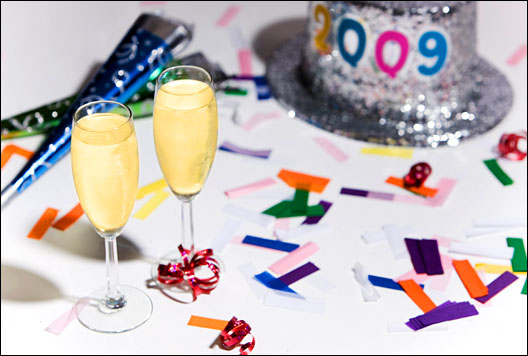
Fewer chemicals in our sparkling wines? We’ll drink to that.
Nothing says festive quite like the pop of a chilled bottle of bubbly.
But while sparkling wine delivers a party in a glass, things are typically less thrilling out in the field. Like most wine, bubbly tends to come from grapes grown in large monocrops — vines as far as the eye can see. And they’re more likely to be swathed in a cloud of pesticide spray than in a farmer’s careful attention.
These grim conditions generally hold sway at all price points, from $5 headache bait to the brand-name Champagnes flaunted by rap stars. In her important book The Search for Wine and Love: Or How I Saved the World from Parkerization, Alice Feiring described a visit to the vineyards of Moet & Chandon, one of the Champagne region’s most prestigious producers. According to Feiring, the soil “looked dead, with a cadaver-like grayness. Chemical weed killer had clearly been deployed instead of vineyard plows.”
Grist’s Pick
Dom. de Montbourgeau Cremant du Jura
Price: $21.99
Feiring champions so-called “grower Champagnes”: wines made within France’s Champagne region by small-scale farmers, not prestige houses like Veuve and Moet. Alas, these tend to be priced out of a reasonable budget. Grower Champagne is lovely stuff, but it’s difficult to find a bottle of it for less than $50.
For this tasting, I wanted distinctive, affordable sparkling wines made from grapes grown on human-scale farms without the use of chemicals. I knew that the “affordable” part would steer me away from Champagne and toward less-hyped regions. How to find them? One option would be to merely seek out certified-organic wines. But that would exclude hundreds of potential candidates that flow out of the so-called “natural wine” movement — vintners who reject chemical farming and modern wine-making techniques, but who also often reject organic certification. (Allergy to certification comes in many forms: an aversion to paperwork, a lingering but now largely antiquated belief that “organic” denotes low-quality wine, or plain curmudgeonliness.)
So I did what anyone should do who wants to identify such wines: I consulted a knowledgeable wine merchant in my area. I asked Jay Murrie, partner and wine director at Chapel Hill-based 3 Cups, to pick out five “natural” sparklers, all under $30. The ones he chose are widely available nationwide, in the kind of shops that seek off-the-beaten-path wines.
I then assembled a panel composed of wine-loving amateurs (my old Maverick Farms colleague Sara Safransky and me) and wine pros (Jay, plus 3 Cups employees Matt Souza and Elaine Thomas). We tasted the wines blind, and — amid the frowning and sniffing and swirling — scribbled down our reactions. I asked everyone to rank the wines by preference. Altogether, the tasting was a mini-New Year’s Eve for wine nerds.
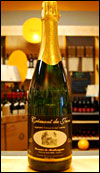
Dom. de Montbourgeau Cremant du Jura
Region: Jura, France
Price: $21.99
Natural note: Hand-harvested grapes come from an eight-hectare farm run by the founder’s granddaughter.
This one took top honors. All three wine pros noted apple flavors. Jay ranked it number one, impressed by its “balance of green-apple fruit and yeast.” Elaine found it “bright, clean, and fruit-driven,” while Matt picked up “some good minerals on the finish” and a “nutty aftertaste.” We amateurs liked it, too. Sara said it “tickles the tongue and keeps going,” while I scribbled “bright, nice acidity, tight bubbles.”
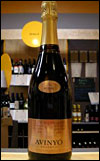
Avinyo Cava Rosado
Region: Penedes, Spain
Price: $25.99
Natural note: Four small organic farms supply the winery; the winemaker consults a 300-year-old book for farming tips.
This pink wine (the only rosé in our tasting) placed dead last; no one ranked it in the top three. Even so, it’s a delightful, interesting wine that I’d happily drink again. I found a cherryish, almost Kool Aid-like aroma, which gave way to a bone-dry, racy flavor profile. Matt, probably its biggest enthusiast, detected “very fresh flavors — zesty, with a good amount of acidity.” Jay liked its “cranberry/red currant” hints, but found its acidity “pretty severe.” Elaine judged that it would “probably be better with food.”
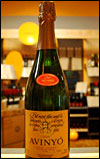
Avinyo Cava Brut
Region: Penedes, Spain
Price: $15.99
Natural note: See above.
Most folks found this one solid but unspectacular. Its biggest enthusiast, Matt, detected floral and mineral notes in the aroma, and “honey, pear, and wildflower” flavors. Elaine judged it “pleasant, but not much personality,” while Jay declared it “fine, but miles from decent Champagne.” I was intrigued by its “lemony, citrus nose,” but not wowed by the flavor.
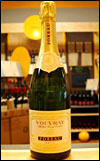
Foreau Vouvray Brut
Region: Loire Valley (Vouvray), France
Varietal(s): Chenin blanc
Price: $26.99
Natural note: 12-hectare farm managed organically; yields intentionally held down to privilege quality over quantity.
This one pleased the panel. Matt found “aromas of earth and leaves and some kind of exotic fruit (mango?).” Jay detected a “really lovely soapy/chalky aroma,” with lavender, honey, and pear notes on the palate. “Double-yum,” he concluded. Elaine picked up “good layers of fruit and mineral and acidity.” I loved it. I found the nose intensely earthy and slightly honeyish — like hanging out near a beehive in high summer. And on the palate, a long, bracing acidity. Sara praised the quality of the bubbles.
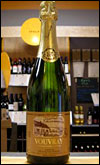
François Pinon Vouvray Petillant Brut
Region: Loire Valley (Vouvray), France
Price: $20.99
Natural note: Supplied by 14 hectares of organically managed land, with a variety of microclimates and soil types.
Another attractive sparkler. I was its biggest admirer, ranking it No. 1. I found pretty fruit notes on the nose, including pineapple. On the palate, I picked up lemon peel and honey, and enjoyed its feather-light effervescence. Jay found it “really well made” and “elegant,” with apple and pear notes. Matt detected raw nuts and sake aromas, and pear flavors. Elaine found wheat on the nose and praised its “good lengthy finish,” but wished it had more acidity. Sara enjoyed its “fruity undertones” and “very mild sparkle.”
Bottom Line: “Natural” sparklers rock, if this tasting is any indication. They may be a little more cerebral than what folks are used to quaffing on New Year’s Eve — they ask you to slow down and contemplate, but they also offer plenty of fun flavor. The panel’s favorite, the Dom. de Montbourgeau Cremant, is a worthy choice, but I’d be pleased to toast the New Year with any of them.


